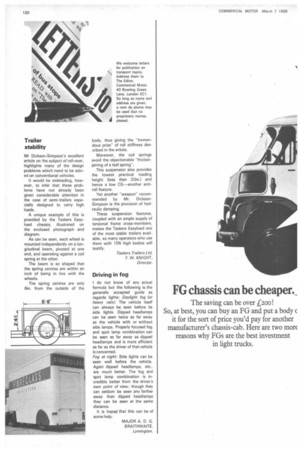to.
Page 122

If you've noticed an error in this article please click here to report it so we can fix it.
Trailer stability
Mr Dickson-Simpson's excellent article on the subject of roll-over, highlights many of the design problems which need to be solved on conventional vehicles.
It would be misleading, however, to infer that these problems have not already been given considerable attention in the case of semi-trailers especially designed to carry high loads.
A unique example of this is provided by the Taskers Easyload chassis, illustrated on the enclosed photograph and diagram.
As can be seen, each wheel is mounted independently on a longitudinal beam, pivoted at one end, and operating against a coil spring at the other.
The beam is so shaped that the spring centres are within an inch of being in line with the wheels.
The spring centres are only 6in. from the outside of the body, thus giving the "tremendous prize" of roll stiffness described in the article.
Moreover, the coil springs avoid the objectionable "frictionjarring of a leaf spring".
This suspension also provides the lowest practical loading height (less than 20in.) and hence a low CO—another antiroll feature.
Yet another "weapon" recommended by Mr. DicksonSimpson is the provision of hydraulic damping.
These suspension features, coupled with an ample supply of torsional frame cross-members, makes the Taskers Easyload one of the most stable trailers avail' able, as many operators who use them with 10ft high bodies will testify.
Taskers Trailers Ltd. F.W. KNIGHT, Director.
Driving in fog
I do not know of any actual formula but the following is the generally accepted guide as regards lights: Daylight fog (or heavy rain): The vehicle itself can always be seen before its side lights. Dipped headlamps can be seen twice as far away as the vehicle with or without side lamps. Properly focused fog and spot lamp combination can be seen as far away as dipped headlamps and is more efficient as far as the driver of that vehicle is concerned.
Fog at night: Side lights can be seen well before the vehicle. Again dipped headlamps, etc.. are much better. The fog and spot lamp combination is incredibly better from the driver's own point of view: though they can seldom be seen any farther away than dipped headlamps they can be seen at the same distance.
It is hoped that this can be of some help.
MAJOR A. D. G. B RAITHWAITE, Lymington.












































































































































































